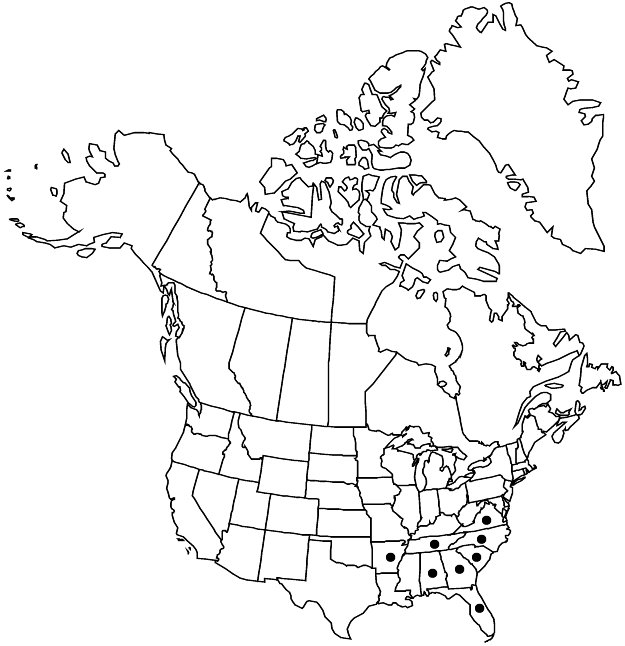Difference between revisions of "Minuartia godfreyi"
Rhodora 82: 498. 1980.
FNA>Volume Importer |
FNA>Volume Importer |
||
| Line 28: | Line 28: | ||
|distribution=Ala.;Ark.;Fla.;Ga.;N.C.;S.C.;Tenn.;Va. | |distribution=Ala.;Ark.;Fla.;Ga.;N.C.;S.C.;Tenn.;Va. | ||
|discussion=<p>Of conservation concern.</p><!-- | |discussion=<p>Of conservation concern.</p><!-- | ||
| − | --><p>Minuartia godfreyi is known from few, very widely scattered populations; it may be most closely related to M. patula and M. muscorum, sharing prominently ribbed sepals with both taxa and black, muriculate-papillate seeds with the latter (R. Kral 1983).</p> | + | --><p><i>Minuartia godfreyi</i> is known from few, very widely scattered populations; it may be most closely related to <i>M. patula</i> and <i>M. muscorum</i>, sharing prominently ribbed sepals with both taxa and black, muriculate-papillate seeds with the latter (R. Kral 1983).</p> |
|tables= | |tables= | ||
|references= | |references= | ||
| Line 52: | Line 52: | ||
|publication year=1980 | |publication year=1980 | ||
|special status= | |special status= | ||
| − | |source xml=https://jpend@bitbucket.org/aafc-mbb/fna-data-curation.git/src/ | + | |source xml=https://jpend@bitbucket.org/aafc-mbb/fna-data-curation.git/src/8f726806613d60c220dc4493de13607dd3150896/coarse_grained_fna_xml/V5/V5_256.xml |
|subfamily=Caryophyllaceae subfam. Alsinoideae | |subfamily=Caryophyllaceae subfam. Alsinoideae | ||
|genus=Minuartia | |genus=Minuartia | ||
Revision as of 17:37, 18 September 2019
Plants short-lived perennial or winter annual. Taproots filiform. Stems erect or ascending, arising from mats of slender, prostrate or ascending, wintering stems, green, 10–40 cm, occasionally stipitate-glandular at nodes, internodes of all stems 1–3 times as long as leaves. Leaves sometimes overlapping proximally, connate proximally, with ± loose, herbaceous sheath 0.2–0.4 mm; blade widely spreading to erect, green, 1-veined abaxially, flat, narrowly elliptic (proximal petiolate blades) to linear (remaining cauline blades), 8–30 × 0.5–3 mm, flexuous, margins not thickened, scarious, occasionally stipitate-glandular, apex green, acute to acuminate, shiny, glabrous; axillary leaves absent. Inflorescences 3–5(–7)-flowered, open, leafy cymes; bracts linear to lanceolate, herbaceous. Pedicels 1–5 cm, sparsely glandular. Flowers: hypanthium disc-shaped; sepals 3-veined, lanceolate (herbaceous portion linear-lanceolate to lanceolate), 3.5–5 mm, not enlarging in fruit, apex often purple, acute, not hooded, stipitate-glandular; petals oblong-spatulate, 2.5–3 times as long as sepals, apex rounded, shallowly notched. Capsules on stipe ca. 0.2 mm, ovoid, 4 mm, shorter than sepals. Seeds black, suborbiculate to reniform, radicle obscure, laterally compressed, 0.6–0.8 mm, muriculate-papillate.
Phenology: Flowering spring.
Habitat: Open mesic meadows, seeps, and stream banks
Elevation: 0-400 m
Distribution

Ala., Ark., Fla., Ga., N.C., S.C., Tenn., Va.
Discussion
Of conservation concern.
Minuartia godfreyi is known from few, very widely scattered populations; it may be most closely related to M. patula and M. muscorum, sharing prominently ribbed sepals with both taxa and black, muriculate-papillate seeds with the latter (R. Kral 1983).
Selected References
None.